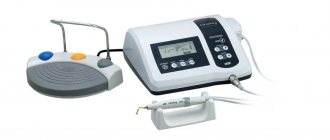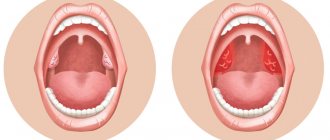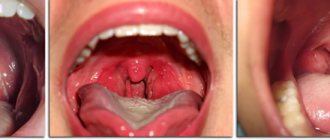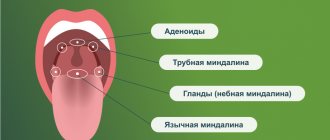What is rinsing the tonsils with the Tonsillor device?
This method combines three types of effects on the tonsils:
- Mechanical. Vacuum pressure helps expel purulent plugs from lacunae.
- Physiotherapeutic. Ultrasonic treatment of the affected lymphoid tissue disinfects, suppresses the activity of bacteria and other possible pathogenic microorganisms, and stops the inflammatory process. Ultrasound also improves blood flow to the ENT organs and microcirculation, which ensures deep penetration of the medicine into the tonsils.
- Medication. The use of saline solution or anesthetic serves to wash out purulent plugs. An antibiotic or glucocorticosteroid drug is then administered to combat local inflammation and infectious agents.
This combination of therapeutic effects, especially against the background of parallel drug therapy to strengthen the immune system, usually gives quick and long-term results.
Causes
The etiology and pathogenesis of chronic tonsillitis has not been fully studied to date.
The starting mechanism in the development of chronic tonsillitis is repeated inflammatory processes leading to local immunosuppression.
- Local causes are infectious foci (carious teeth, purulent sinusitis, etc.).
- Pathogenic and opportunistic microorganisms.
- Immunodeficiency states.
- Persistent violation of nasal breathing (adenoids in children, deviated nasal septum, etc.).
- Allergic sensitization of the body.
How is the tonsils washed with the Tonsillor device?
This method is distinguished by its gentle effect on the palatine tonsils, compared to surgery and even rinsing with a syringe. And yet, some patients are afraid of hardware treatment, assuming that it is painful. Such fears are unfounded.
Unpleasant sensations are relieved by first applying an anesthetic solution to the affected area, which weakens sensitivity and prevents the occurrence of a gag reflex.
Then, using a nozzle operating in vacuum cleaning mode, the purulent contents are drawn out from the lacunae. Then comes the turn of ultrasonic treatment in combination with washing with saline solution or an antiseptic (furatsilin, miramistin, etc.) and administration of drugs.
A session of washing the lacunae of the tonsils with the Tonzillor apparatus lasts no more than 10 minutes. Patients usually feel relief after the first time. For most patients, 5–10 sessions are enough to forget about the disease for a long time. If necessary, the course can be repeated after six months.
What should you be prepared for when undergoing hardware treatment for tonsils? Firstly, after each session for 3-4 hours, slight soreness may be felt in the throat due to the cessation of the anesthetic effect. It is better not to drink or eat for at least an hour. By the way, for the entire period of therapy you should avoid foods and drinks that irritate the mucous membranes. Spicy, rough, too hot or cold food is not advisable. Secondly, plugs often come off not only during the cleaning process, but also in the intervals between procedures; there is no need to be afraid of this.
Frequently asked questions related to the procedure
- How many treatments are needed? To get rid of tonsillitis you need to undergo 5-10 procedures. The specific number is determined by the doctor depending on the extent of the inflammatory process.
- Is pain relief provided? Although irrigation is carried out without a needle, local anesthesia is still used. They do this to reduce discomfort during manipulation.
- How to prepare for the procedure? Preparation consists of refusing to eat at least an hour before the upcoming wash.
- How often should you rinse your tonsils? The need for the procedure depends on the activity of the disease and the rate of accumulation of fluid, food particles, and bacteria in the lacunae. Only the attending physician can determine the frequency of washing. At least once a day.
- How long should I rinse my tonsils? Even if during a single procedure it was possible to completely remove the contents of the lacunae, the manipulation will have to be repeated at least 7-10 more times, it is better to do it every day. This is due to the constant proliferation of pathogenic microflora. And this approach will allow you to achieve stable remission.
- Are there any special features of oral hygiene during the course of treatment? During the course of treatment after each procedure, it is prohibited to eat for the first two hours. It is also worth giving up solid food during this period, since after eating it, a piece may get stuck in the passages.
Thus, washing the tonsils for tonsillitis is an effective treatment method. But if carried out incorrectly, a serious complication can develop, so it is better to contact a specialist.
Effects of hardware washing of tonsils
In most cases, a course of rinsing the tonsils with the Tonsillor apparatus is effective in several ways:
- powerful antibacterial effect, expulsion of pathogenic bacteria and toxic waste from the ENT organs being sanitized, normalization of the microflora of the oral cavity;
- intensification of the process of penetration of drugs deep into the tonsils;
- activation of local blood circulation, metabolism, nutrition and restoration of lymphoid tissue of the tonsils at the cellular level;
- anti-inflammatory effect;
- inclusion of local immunity.
Cauterization methods
| Method | What is used | Advantages | Flaws |
| Cryotherapy | A liquid nitrogen. Under the influence of liquid nitrogen, the tissue is greatly cooled. Ice crystals form inside the cells, destroying the cell wall. | Bloodless, painless method. Well tolerated by elderly patients. | To achieve a lasting effect, a course of procedures is required. |
| Laser ablation | CO2 laser, holminium or fiber optic laser. The effect is based on the evaporation of liquid (coagulation) of tissue due to laser heating. | Bloodless, painless method. | Heating of the tissues surrounding the tonsil, the formation of a layer of dead tissue, which disappears within 5-7 days. Within 2-3 days after the procedure, discomfort in the throat, similar to a cold. |
| Radio wave ablation | Alternating high-frequency current (radiosurgery devices Surgitron, Curis). The effect is achieved by heating the tissue and evaporating liquid from it. | Bloodless, painless method, good wound healing, gentle effect on surrounding tissues. The procedure is carried out once, and can be repeated after several years. | The formation of a layer of dead tissue, which disappears within 5-7 days; the next day after the procedure, discomfort in the throat, similar to a cold. |
What are the benefits of washing the tonsils with the Tonzillor device?
Treatment of tonsillitis and other ENT diseases with the help of Tonsillor has a number of advantages compared to the “old-fashioned” method of washing out pus from lacunae with a syringe.
- There is no risk of injury to lymphoid tissue. Hardware attachments with soft edges are attached to the tonsils extremely delicately. In addition, during the process of pulling out plugs using a vacuum, the doctor adjusts the pressure, depending on the area being treated.
- The spread of infection to neighboring areas is excluded. All pus removed from the patient immediately enters the appropriate reservoir, without contacting the surrounding tissues.
- Maximum deep cleaning of gaps. Tonsillor is able to free even very small and narrow depressions in the lymphoid tissue from “clogging,” which cannot be accomplished by other methods.
- Painless.
And, undoubtedly, rinsing the tonsils with a vacuum method compared to removing them is a preferable choice. After all, the body’s immune defense and hematopoietic processes depend on the integrity and functional suitability of this organ.
Syringe method
This is the most common and accessible method of performing the procedure. And most likely, when you go to the district clinic, you will be offered exactly this.
To carry out the procedure, a needle-free syringe with a curved cannula attached to it is used. An antiseptic solution, for example, a furatsilin solution, is drawn into the syringe. The syringe directs a stream of solution directly into the lacuna. The jet “breaks” the tonsillitis plug. Purulent masses, washed out of the lacunae by the solution, enter the mouth. At this moment, the patient must spit the washing solution into a special tray along with the washed purulent contents. As soon as the manipulation is completed, the surface of the tonsils is lubricated with Lugol's solution.
This method is referred to as the old, “grandfather” methods. Yes, this method is inexpensive, but it cannot be called very effective either. With this technique it is impossible to completely rinse the tonsils and remove deeply located caseous masses. Also, such sanitation requires good professional training from the otolaryngologist. An inexperienced ENT doctor can injure the surface of the tonsils with a syringe, which will lead to the spread of infection to healthy tissue, which will only worsen the situation.
The apparent simplicity of performing such a flush convinces patients to buy a syringe at a pharmacy and try to carry out the procedure at home. But only a few manage to cope. Firstly, we should not forget about the traumatic nature of the method, and secondly, it is not possible to maintain the proper level of sterility at home.
Sanitation with a syringe is an inexpensive and accessible method. But it is much more effective to carry out vacuum rinsing using the Tonzillor apparatus.
Who is recommended to wash the tonsils with the Tonsillor device?
The main indication for ENT procedures is tonsillitis . This is an acute or chronic disease of the tonsils of an infectious nature.
The developmental features and difficulties of treating this pathology are due to the structural specificity of the tonsils. The presence in them of a large number of depressions (crypts, or lacunae) actually serves the good purpose of increasing the surface of this paired organ - a barrier to infections entering the body. But it is precisely this property of the tonsils that causes the accumulation of pathogenic bacteria in them. The warm and humid climate of lymphoid “gorges” that are difficult to rinse is simply ideal for the growth of colonies of cocci, staphylococci and streptococci.
That is why acute tonsillitis easily turns into chronic, when the source of infection in the depths of the tonsils becomes permanent. The chronic form of the pathology is characterized by:
- frequent exacerbations (at the slightest cooling), tendency to sore throats;
- bad breath, periodic release of lumps of pus;
- soreness and increased size of the tonsils themselves and often visible whitish-yellowish deposits on their surface;
- intoxication of the body, since harmful waste products of pyogenic bacteria are carried by the bloodstream throughout the body, which can cause complications in the heart, kidneys, joints, provoking the development of myocarditis, pyelonephritis, arthritis, etc.
Attempts to treat tonsillitis by taking antibiotics, rinsing, and treating with antibacterial drugs are usually ineffective due to the hidden source of infection deep in the lymphoid tissue. Therefore, ENT rinsing of the tonsils is prescribed as the most productive method.
In addition, vacuum washing of the tonsils can be prescribed for ENT pathologies such as tonsillitis, rhinitis, adenoiditis, pharyngitis . Sanitation of the tonsils using the vacuum method is also carried out after removal of various tumors in the mouth and throat, including papillomas.
Tonsil types, location
Tonsils are either paired or unpaired. Paired tonsils are the palatine tonsils, the inflammatory process in which is called chronic tonsillitis, and we know an acute infectious disease as a diagnosis - “tonsillitis”. There are also tubal rollers or tubal tonsils. They border the entrance to the pharyngeal mouth of the auditory tube.
The unpaired tonsils include the pharyngeal and lingual tonsils. The growth of the pharyngeal tonsil is nothing more than the adenoids known to everyone. The lingual tonsil is located at the root of the tongue. The totality of all tonsils forms the Pirogov-Waldeyer lymphoid pharyngeal ring.
In newly born babies, the tonsils are still undeveloped, and only by two or three months do they begin to gradually perform their protective functions. Adenoids develop much more actively in early childhood. During this period, children are most susceptible to infections and diseases. Over time, the number of antibodies that are designed to fight bacteria grows, and by the age of nine to ten years, the lymphoid tissue of the adenoids decreases, and by the time the child reaches adulthood, small particles remain of it, or even disappear completely. The tonsils are fully developed in their development by the age of two. By the age of five to seven years, the tonsils reach their optimal size. Numerous vaccinations also contribute to the growth activity of the tonsils.
Below we will consider in detail what methods exist for washing the tonsils in adults and children.
Inflammation in the tonsils (tonsils)
The inflammatory process occurring in the palatine tonsils is called tonsillitis. Tonsillitis is a disease that affects children quite often. It has two forms: acute and chronic. The causative agents of the disease are staphylococci, streptococci and other viruses. The disease spreads primarily through airborne droplets, and the peak incidence occurs in autumn and winter. The first signs of acute tonsillitis (tonsillitis) are:
- high body temperature up to 39 C°;
- lethargy, weakness, adynamia;
- severe sore throat, pain when swallowing;
- the whole body “aches”;
- vomiting, in the youngest - abdominal pain;
- headache;
- redness of the throat, rashes appearing on the back of the throat;
Under favorable conditions, the disease goes away within a week. In the absence of proper treatment, the acute form can become chronic.
Who is contraindicated for washing the tonsils with the Tonzillor device?
In some cases, washing the lacunae of the tonsils with the Tonzillor device may be contraindicated or should be carried out with caution under the especially vigilant supervision of a physician. Contraindications include:
- acute course of an ENT disease, accompanied by fever and severe inflammation;
- acute respiratory viral diseases, including influenza, covid, etc.;
- severe tuberculosis;
- some ophthalmological diseases associated with ruptures and weakness, retinal dystrophy;
- individual intolerance to drugs used during the procedure;
- the presence of malignant tumors, no matter in what part of the body;
- III degree of hypertension;
- problems with blood clotting;
- the first three and last three months of pregnancy;
- children up to three years of age.
Washing the tonsils with the Tonsillor apparatus for children
Before the age of five, hardware lavage of the tonsils is rarely prescribed due to the psychological unpreparedness of children. After all, anesthesia for this procedure is not justified, but it is extremely important that the patient remains motionless. Small children are not capable of this. And even after five years, it is very important to set the child up correctly so that he is not afraid and behaves calmly.
Preparing for vacuum rinsing of tonsils
To prescribe a course of washing the tonsils, you need to consult an otolaryngologist, who will perform an examination and, possibly, give a referral for a number of examinations:
- general blood analysis;
- examination of the microflora of the tonsils for bacterial damage;
- rheumatic tests to determine the intensity of inflammation and the risks of developing complications of tonsillitis in other organs.
In order for the vacuum cleaning session of the tonsils to take place without any excesses from the gastrointestinal tract, doctors strongly advise not to eat 3 hours before the start of the procedure. The fact is that the risk of a gag reflex, although reduced due to the anesthetic, still does not disappear completely. You will receive more detailed recommendations when making an appointment by phone.
Chronic tonsillitis
Tonsillitis is considered chronic if tonsillitis occurs more than twice a year. A distinctive feature of the chronic form of the disease is the accumulation of caseous masses in the lacunae of the palatine tonsils, which is very dangerous. Lacunae are openings on the surface of the tonsils, with winding canals and passages inside the tonsil. These in turn are called crypts. In a healthy person, the lacunae are independently cleansed of dead leukocytes and bacteria, but with tonsillitis, the self-cleaning function weakens and whitish caseous plugs are visible in the lacunae. Thus, staphylococcal and streptococcal infections are constantly present in the body, and can easily migrate from the tonsils to adjacent organs. Inflammatory processes can begin, for example, in the kidneys, joints or heart. Therefore, it is necessary to periodically clean the tonsils from pus.
Washing of tonsil lacunae: price
One session of hardware washing of tonsil lacunae will cost you only 300 rubles. As a result, even for a 10-day course you will spend the same amount that you regularly leave at the pharmacy, unsuccessfully fighting chronic tonsillitis with medicinal methods. Only now the efficiency will be many times higher!
Remember that chronic tonsillitis is an insidious pathology, fraught with systemic complications from a number of organs and systems. Therefore, it is worth getting rid of it as soon as possible. This will be done by specialists from the Healthy Children MC at st. Sverdlova, 4 and MC “Secrets of Longevity” at Druzhby, 21.
You can make an appointment by phone (Sverdlov St., 4), (Druzhby St., 21).










